Comparison of Flood Resilience Between Low-Carbon and Traditional Communities: A Case Study of Kunming, China
Abstract
1. Introduction
2. Study Area and Data Sources
2.1. Study Area
2.2. Data Sources
3. Methods and Models
3.1. Evaluation System Construction
3.2. Determine the Indicator Weights Based on the Critic–Entropy Weight Combination Weighting Method
| Number | Critic Method Weight | Entropy Method Weight | Critic–Entropy Weight |
|---|---|---|---|
| C1 | 0.0928 | 0.0704 | 0.0816 |
| C2 | 0.0383 | 0.0009 | 0.0196 |
| C3 | 0.0319 | 0.1204 | 0.0762 |
| C4 | 0.1007 | 0.0599 | 0.0803 |
| C5 | 0.0375 | 0.0692 | 0.0534 |
| C6 | 0.0516 | 0.0017 | 0.0267 |
| C7 | 0.1471 | 0.0689 | 0.1080 |
| C8 | 0.1436 | 0.0689 | 0.1063 |
| C9 | 0.0202 | 0.0822 | 0.0512 |
| C10 | 0.0484 | 0.0477 | 0.0481 |
| C11 | 0.0458 | 0.0773 | 0.0616 |
| C12 | 0.1479 | 0.0758 | 0.1119 |
| C13 | 0.0714 | 0.1622 | 0.1168 |
| C14 | 0.0229 | 0.0944 | 0.0587 |
| Number | Critic Method Weight | Entropy Method Weight | Critic–Entropy Weight |
|---|---|---|---|
| C15 | 0.0661 | 0.0062 | 0.0362 |
| C16 | 0.0971 | 0.0209 | 0.0590 |
| C17 | 0.1296 | 0.1301 | 0.1299 |
| C18 | 0.0665 | 0.0883 | 0.0774 |
| C19 | 0.0861 | 0.2811 | 0.1836 |
| C20 | 0.1823 | 0.1693 | 0.1758 |
| C21 | 0.0768 | 0.1269 | 0.1019 |
| C22 | 0.2004 | 0.0486 | 0.1245 |
| C23 | 0.0590 | 0.1279 | 0.0935 |
| C24 | 0.0361 | 0.0007 | 0.0184 |
3.3. Calculation of Evaluation Results Based on TOPSIS Method
3.4. Geographic Detector
3.5. Coupling Coordination Analysis Model
3.6. Spatial Autocorrelation Model
4. Results and Discussion
4.1. Evaluating Flood Resilience in Traditional and Low-Carbon Communities
4.2. Evaluating Low-Carbon Development Level in Traditional and Low-Carbon Communities
4.3. Analyzing the Coupling Coordination Degree Between Flood Resilience and Low-Carbon Development in Traditional and Low-Carbon Communities
4.3.1. Spatial Differentiation Characteristics of Coupling Coordination Degree
4.3.2. Analysis of Spatial Correlation Characteristics of Coupling Coordination Degree
5. Conclusions and Suggestions
6. Limitations
Author Contributions
Funding
Data Availability Statement
Acknowledgments
Conflicts of Interest
References
- IPCC. Climate Change 2014: Mitigation of Climate Change; Cambridge University Press: Cambridge, UK, 2014. [Google Scholar]
- Allen, M.R.; Ingram, W.J. Constraints on future changes in climate and the hydrologic cycle. Nature 2002, 419, 228–232. [Google Scholar] [CrossRef] [PubMed]
- Fischer, E.M.; Knutti, R. Anthropogenic contribution to global occurrence of heavy-precipitation and high-temperature extremes. Nat. Clim. Change 2015, 5, 560–564. [Google Scholar] [CrossRef]
- Luo, Y.H.; Du, Y. The roles of low-level jets in “21·7” Henan extremely persistent heavy rainfall event. Adv. Atmos. Sci. 2023, 40, 350–373. [Google Scholar] [CrossRef]
- Yang, X.L.; Jin, X.Q.; Sun, Y.; Chen, B.; Liang, T.; Yang, M.; Yan, X.; Li, J. Characteristics and causes of the “23·7” rare heavy rain at the eastern foot of Taihang Mountain in Hebei province. Meteorol. J. 2023, 49, 1451–1467. [Google Scholar]
- Ma, H. One More Degree of News|Urban Flooding, Factory Shutdowns. How Serious Is the Flood Situation in Pingjiang? The Beijing News, 3 July 2023. Available online: https://www.bjnews.com.cn/detail/1719999024129733.html (accessed on 4 May 2024).
- Deng, Z.; Gao, W.; Liao, Y.; Wang, Z.-L. Research progress on the impact of climate change on urban rainstorms and floods. J. North China Univ. Water Resour. Electr. Power (Nat. Sci. Ed.) 2024, 45, 1–14. [Google Scholar]
- Qin, J. Study on flood adaptation Strategy of national spatial planning in response to climate change. Planners 2023, 39, 30–37. [Google Scholar]
- Wu, Y.J.; Ma, B. City of wisdom and resilience: Foreign experience and reference. Strategy Manag. 2016. Available online: https://www.cssm.org.cn/view.php?id=33200 (accessed on 24 June 2025).
- UNISDR. Global Assessment Report on Disaster Risk Reduction 2019; United Nations: New York, NY, USA, 2019. [Google Scholar]
- Zhang, J.; Luo, Q.; Wang, B.; Li, R. Research progress and prospect on causes and countermeasures of urban extreme rainstorm floods. Water Resour. Prot. 2024, 40, 6–15. [Google Scholar]
- Wang, K.; Zhang, H.; Li, G.; Zhang, C.; Wang, H.; Mu, J.; Wang, G. Review on research progress and key supporting technologies of urban flood resilience. Water Resour. Hydropower Technol. (Engl. Chin.) 2023, 54, 77–88. [Google Scholar]
- Zhang, J.; Wang, Y.; He, R.; Hu, Q.; Song, X. Urban flooding and its causes in China. Adv. Water Sci. 2016, 27, 485–491. [Google Scholar]
- Zhang, D.; Yan, D.; Wang, Y.; Lu, F.; Liu, S. Research progress of urban waterlogging disaster risk assessment and comprehensive response. Catastrophology 2014, 29, 144–149. [Google Scholar]
- Oladokun, V.O.; Proverbs, D.G.; Lamond, J. Measuring flood resilience: A fuzzy logic approach. Int. J. Build. Pathol. Adapt. 2017, 35, 470–487. [Google Scholar] [CrossRef]
- Karamouz, M.; Taheri, M.; Khalili, P.; Chen, X. Building infrastructure resilience in coastal flood risk management. J. Water Resour. Plan. Manag. 2019, 145, 04019004. [Google Scholar] [CrossRef]
- Simonovic, S.P.; Peck, A. Resilience to climate change-caused flooding—Metro vancouver case study. River 2022, 1, 47–59. [Google Scholar] [CrossRef]
- Miguez, M.G.; Verl, A.P. A catchment scale Integrated Flood Resilience Index to support decision making in urban flood control. Environ. Plan. B Urban Anal. City Sci. 2017, 44, 925–946. [Google Scholar] [CrossRef]
- Bertilsson, L.; Wiklund, K.; De Tebaldi, I.M.; Rezende, O.M.; Veról, A.P.; Miguez, M.G. Urban flood resilience: A multicriteria index to integrate flood resilience into urban planning. J. Hydrol. 2019, 573, 970–982. [Google Scholar] [CrossRef]
- Singh, P.; Sinha, V.; Vijhani, A.; Pahuja, N. Vulnerability Assessment of urban road network from urban flood. Int. J. Disaster Risk Reduct. 2018, 28, 237–250. [Google Scholar] [CrossRef]
- Moghadas, M.; Asadzadeh, A.; Vafeidis, A.; Fekete, A.; Kötter, T. A multi-criteria approach for assessing urban flood resilience in Tehran, Iran. Int. J. Disaster Risk Reduct. 2019, 35, 101069. [Google Scholar] [CrossRef]
- Cutter, S.L.; Burton, C.G.; Emrch, C.T. Disaster resilience indicators for benchmarking baseline conditions. J. Homel. Secur. Emerg. Manag. 2010, 7, 1–22. [Google Scholar] [CrossRef]
- Liu, C.; Shang, S.; Zhao, Q.; Xie, H. Evaluation of resilience after flood disaster in Hunan Province based on GIS and TOPSIS-PSR. Hydropower Energy Sci. 2018, 36, 70–73. [Google Scholar]
- The Compilation Committee of the Fourth National Assessment Report on Climate Change. The Fourth National Assessment Report on Climate Change; Science Press: Beijing, China, 2022; pp. 3–435.
- Zhou, Q.; Leng, G.; Huang, M. Impacts of future climate change on urban flood volumes in Hohhot in northern china: Benefits of climate change mitigation and adaptations. Hydrol. Earth Syst. Sci. 2018, 22, 305–316. [Google Scholar] [CrossRef]
- Hurlimann, A.; Moosavi, S.; Browne, G.R. Urban planning policy must do more to integrate climate change adaptation and mitigation actions. Land Use Policy 2021, 101, 105188. [Google Scholar] [CrossRef]
- Li, F.; Wang, L.; Zhao, Y. Evolvement rules of basin flood risk under low-carbon mode. Part II: Risk assessment of flood disaster under different land use patterns in the Haihe basin. Environ. Monit. Assess 2017, 189, 397. [Google Scholar] [CrossRef]
- Nakamichi, K.; Yamagata, Y.; Seya, H. An Integrated Model for Assessing Carbon Dioxide Emissions Considering Climate Change Mitigation and Flood Risk Adaptation Interaction. In Monitoring and Modeling of Global Changes: A Geomatics Perspective. Springer Remote Sensing/Photogrammetry; Li, J., Yang, X., Eds.; Springer: Dordrecht, The Netherlands, 2015. [Google Scholar]
- Yang, W.; Zhang, J.; Krebs, P. Investigating flood exposure induced socioeconomic risk and mitigation strategy under climate change and urbanization at a city scale. J. Clean. Prod. 2023, 387, 135929. [Google Scholar] [CrossRef]
- Guo, X.; Li, J.; Wu, X.; Liu, H. Study on coupling coordination and influencing factors between urban resilience and low-carbon development in Henan Province. Yellow River 2019, 46, 1–6, 37. [Google Scholar]
- Vorobyev, S.N.; Kolesnichenko, Y.; Karlsson, J.; Pokrovsky, O.S. Carbon emission from the Lower Ob River floodplain during spring flood. Sci. Total Environ. 2024, 954, 176294. [Google Scholar] [CrossRef]
- Wang, T.; Deng, Z.; Zhang, C.; Zou, Y.; Xie, Y.; Li, F.; Xiao, F.; Peng, C. Vegetation types and flood water level are dominant factors controlling the carbon sequestration potential in Dongting Lake floodplain, China. Sci. Total Environ. 2024, 921, 171146. [Google Scholar] [CrossRef]
- Zhang, Z.; Zhu, J.; Yang, L.; Chen, L. Booster or inhibitor: Diagnosing effects of low-carbon pilot city policies on urban resilience from the perspectives of heterogeneity, mechanisms and spillover. J. Clean. Prod. 2024, 474, 143587. [Google Scholar] [CrossRef]
- Younesi, A.; Wang, Z.; Siano, P. Enhancing the resilience of zero-carbon energy communities: Leveraging network reconfiguration and effective load carrying capability quantification. J. Clean. Prod. 2024, 434, 139794. [Google Scholar] [CrossRef]
- Xu, C.; Huo, X.; Hong, Y.; Yu, C.; de Jong, M.; Cheng, B. How urban greening policy affects urban ecological resilience: Quasi-natural experimental evidence from three megacity clusters in China. J. Clean. Prod. 2024, 452, 142223. [Google Scholar] [CrossRef]
- Zhao, L.; Zhang, C.; Wang, Q.; Yang, C.; Suo, X.; Zhang, Q. Climate extremes and land use carbon emissions: Insight from the perspective of sustainable land use in the eastern coast of China. J. Clean. Prod. 2024, 452, 142219. [Google Scholar] [CrossRef]
- Marta, B.G.; Maria, D.B.; Maria, J.R. Sustainability on the urban scale: Proposal of astructure of indicators for the Spanish context. Environ. Impact Assess. Rev. 2015, 53, 16–30. [Google Scholar]
- Tan, S.; Yang, J.; Yan, J.Y.; Lee, C.; Hashim, H.; Chen, B. A holisticlow carbon cityindicator framework forsustainable development. Appl. Energy 2016, 185, 1919–1930. [Google Scholar] [CrossRef]
- Lu, Y.; Zhai, G. International experience and implications of low-carbon resilient city construction under the dual carbon goal. Sci. Technol. Rev. 2022, 40, 56–66. [Google Scholar]
- Zheng, Y.; Wang, W.; Pan, J. Low-carbon Resilient City: Concept, Approach and Policy Choice. Urban Dev. Res. 2013, 20, 10–14. [Google Scholar]
- Wu, Y.; Yan, H.; Shi, Z.; Shu, K. Research on the Response of Heavy Precipitation in Kunming to Urbanization and Thermal Environment Changes. Prog. Clim. Change Res. 2023, 19, 723–737. [Google Scholar]
- He, Y.; Lu, Z. Analysis of Climate Change Characteristics in Kunming City in the Past 60 Years. Sci. Geogr. Sin. 2012, 32, 1119–1124. [Google Scholar]
- Fu, Y. Research on the Optimization of Flood Prevention and Control System in Kunming from the Perspective of Resilient Cities. Master’s Thesis, Yunnan Normal University, Kunming, China, 2020. [Google Scholar]
- Zou, J.; Liu, Z. Analysis of rainstorm flood characteristics in Kunming. Hydropower Energy Sci. 2013, 31, 42–45+187. [Google Scholar]
- GB/T40947-2021; Guide for Safety Resilient City Evaluation. The State Administration for Market Regulation and the Standardization Administration of China: Beijing, China, 2021.
- SZDB/Z 310-2018; Evaluation Guide for Low-Carbon Communities. Shenzhen Market Supervision and Administration Bureau: Shenzhen, China, 2018.
- Wang, P.; Li, Y.; Zhang, Y. An urban system perspective on urban flood resilience using SEM: Evidence from Nanjing city, China. Nat. Hazards 2021, 109, 2575–2599. [Google Scholar] [CrossRef]
- Yan, X. Comprehensive Evaluation and Influencing Factors of Low-Carbon Development Level in the Hohhot-Baotou-Erdos-Yulin Urban Agglomeration. Master’s Thesis, Inner Mongolia University of Science and Technology, Baotou, China, 2023. [Google Scholar]
- Chen, Z.; Wan, S.; Li, X.; Dong, Y.; Li, G. Spatial and temporal evolution and driving factors of urban flood resilience in Hubei Province. China Rural. Water Resour. Hydropower 2024, 6, 21–30. [Google Scholar]
- Fu, X.; Liu, Y.; Xie, Z.; Jiang, F.; Xu, J.; Yang, Z.; Deng, Z.; Wang, Q.; Liao, M.; Wu, X.; et al. A coupled PSR-based framework for holistic modeling and flood resilience assessment: A case study of the 2022 flood events in five southern provinces of China. J. Hydrol. 2024, 636, 131255. [Google Scholar] [CrossRef]
- Meng, X.; Chen, X.; Chen, J.; Yang, H. Application of combinatorial empowerment-TOPSIS in urban regional resilience assessment under flood disaster. J. Saf. Environ. 2023, 23, 1465–1473. [Google Scholar]
- Xu, W.; Yu, Q.; Proverbs, D. Evaluation of Factors Found to Influence Urban Flood Resilience in China. Water 2023, 15, 1887. [Google Scholar] [CrossRef]
- Jiang, F.; Xie, Z.; Xu, J.; Yang, S.; Zheng, D.; Liang, Y.; Hou, Z.; Wang, J. Spatial and component analysis of urban flood Resiliency of kunming city in China. Int. J. Disaster Risk Reduct. 2023, 93, 103759. [Google Scholar] [CrossRef]
- Zhang, L.; Wang, P. Analysis on the Change Characteristics of the Correlation between Land Use Structure and Energy Consumption and Carbon Emissions in Kunming from 1997 to 2017. J. Geosci. Environ. Prot. 2021, 9, 155–166. [Google Scholar] [CrossRef]
- T/GDDTJS 06-2022; Guidance on Zero-Carbon Community Construciton and Evaluation. Guangdong Low-Carbon Industry Technology Association: Guangzhou, China, 2022.
- Zhu, J.; Liu, X.; Zhang, Y. Construction of evaluation index system for low-carbon city construction in China. Ecol. Econ. 2017, 33, 52–56. [Google Scholar]
- Sun, Q.; Wu, Q.; Li, S.; Li, X. Estimation of urban low-carbon development performance index. Stat. Decis. 2021, 37, 75–79. [Google Scholar]
- Chen, J.; Gao, C.; Zhou, H.; Wang, Q.; She, L.; Qing, D.; Cao, C. Urban Flood Risk Assessment Based on a Combination of Subjective and Objective Multi-Weight Methods. Appl. Sci. 2024, 14, 3694. [Google Scholar] [CrossRef]
- Zhang, Z.; Zhang, J.; Zhang, Y.; Chen, Y.; Yan, J. Urban Flood Resilience Evaluation Based on GIS and Multi-Source Data: A Case Study of Changchun City. Remote Sens. 2023, 15, 1872. [Google Scholar] [CrossRef]
- Song, J.Y.; Chung, E.S. Robustness, Uncertainty and Sensitivity Analyses of the TOPSIS Method for Quantitative Climate Change Vulnerability: A Case Study of Flood Damage. Water Resour. Manag. 2016, 30, 4751–4771. [Google Scholar] [CrossRef]
- Wang, J.F.; Xu, C.D. Geographic Detector: Principle and prospective. Acta Geogr. Sin. 2017, 72, 116–134. [Google Scholar]
- Li, N.Q.; Xu, G.Y. Grid analysis of land use based on natural breaks (jenks) classification. Bull. Surv. Mapp. 2020, 4, 106–110+156. [Google Scholar]
- Lei, D.; Xu, X.; Zhang, Y. Analysis of the dynamic characteristics of the coupling relationship between urbanization and environment in Kunming City, Southwest China. Clean. Environ. Syst. 2021, 2, 100018. [Google Scholar] [CrossRef]
- Han, S.; Wang, B.; Ao, Y.; Bahmani, H.; Chai, B. The coupling and coordination degree of urban resilience system: A case study of the Chengdu–Chongqing urban agglomeration. Environ. Impact Assess. Rev. 2023, 101, 107145. [Google Scholar] [CrossRef]
- Ding, Y.; Wang, H.; Liu, Y.; Chai, B.; Bin, C. The spatial overlay effect of urban waterlogging risk and land use value. Sci. Total Environ. 2024, 947, 174290. [Google Scholar] [CrossRef]
- Zhang, Z.; Dai, X.; Xie, Z.; Yu, C.; Liao, Z.; Li, J.; Jiang, F.; Liu, Y.; Liu, Z.; Zhang, Q.; et al. Spatiotemporal Variation Characteristics and Influencing Factors of Air Quality in Sichuan-Chongqing Region, China, 2016–2020. Environ. Earth Sci. 2025, 84, 115. [Google Scholar] [CrossRef]
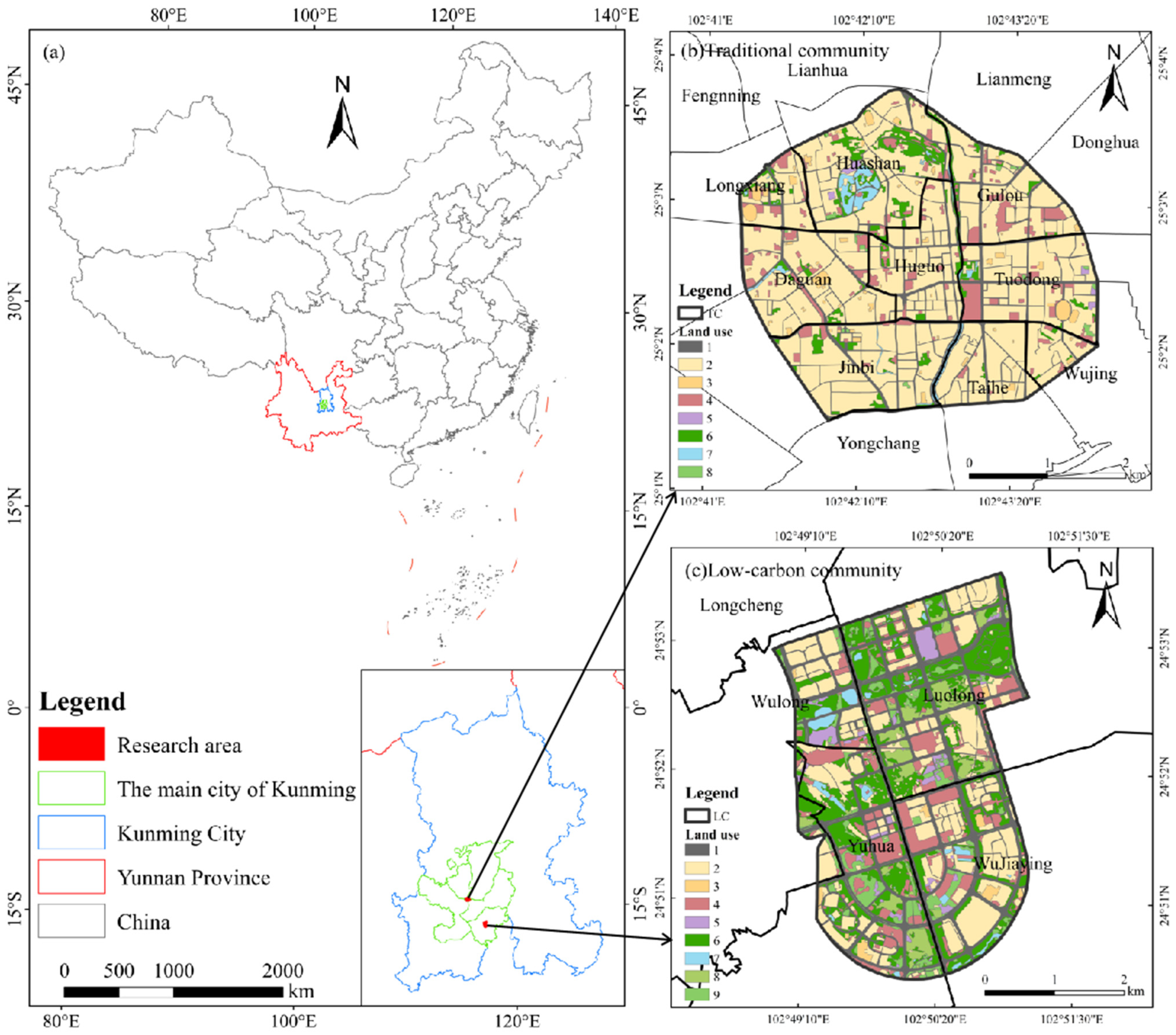



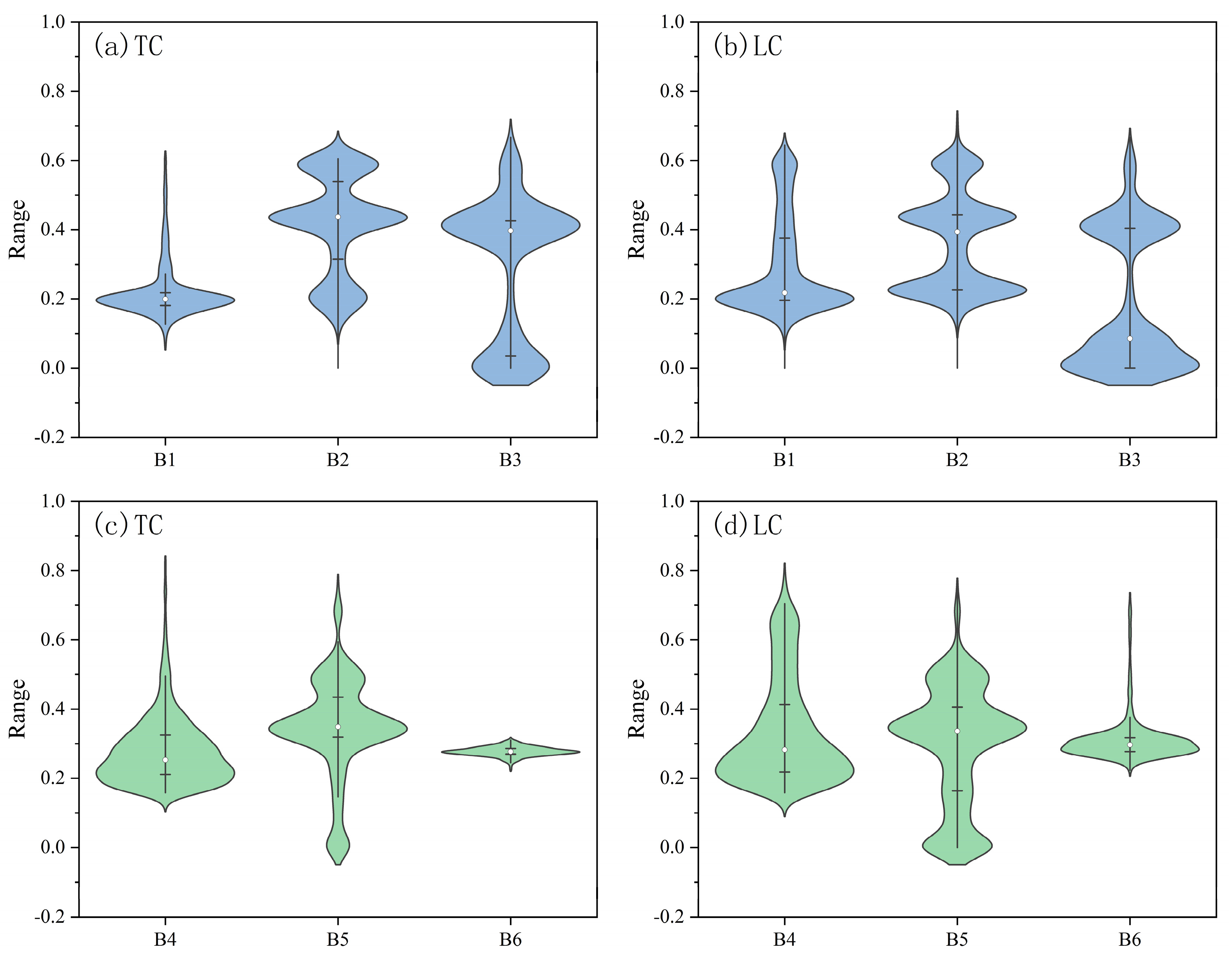

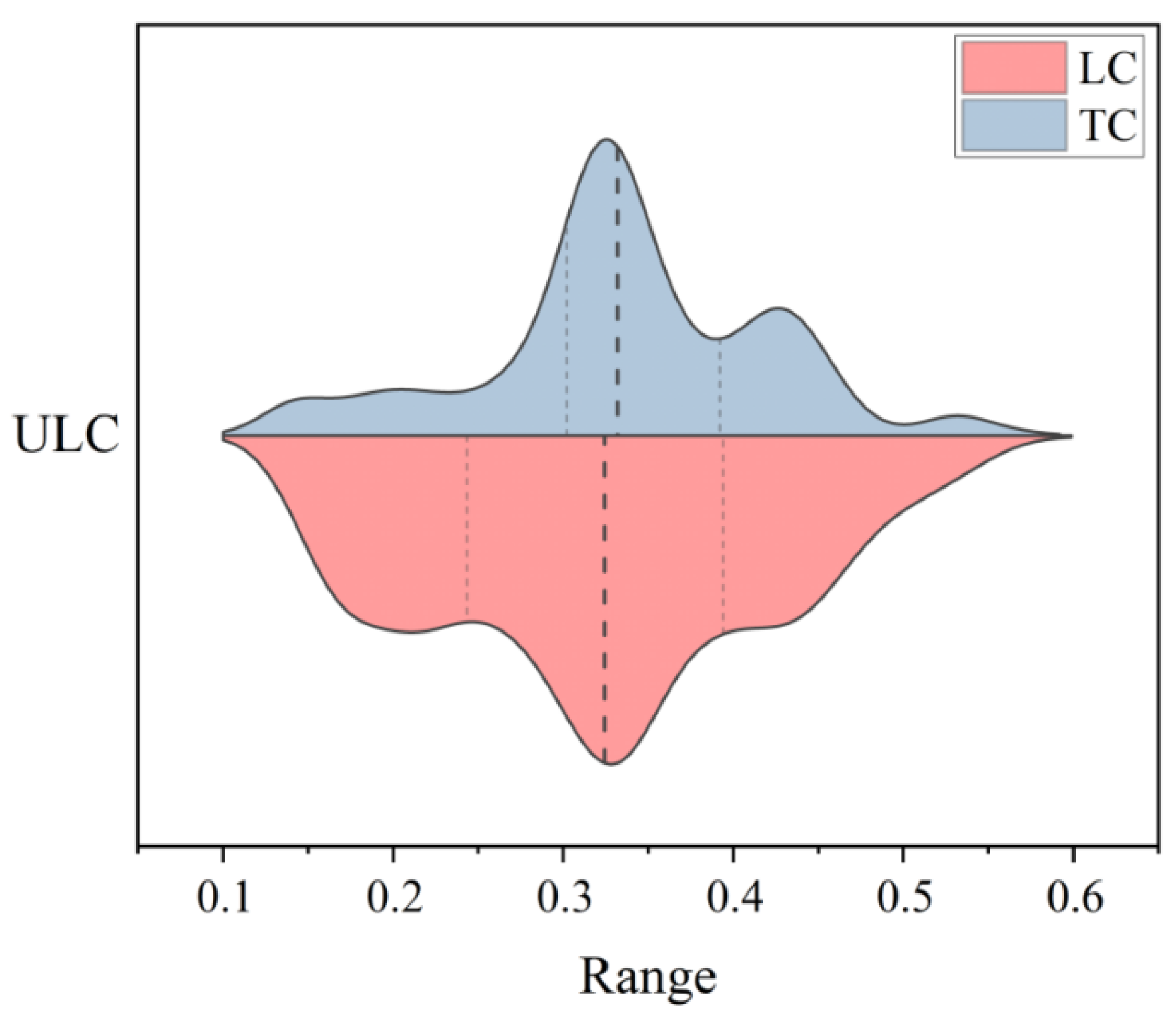
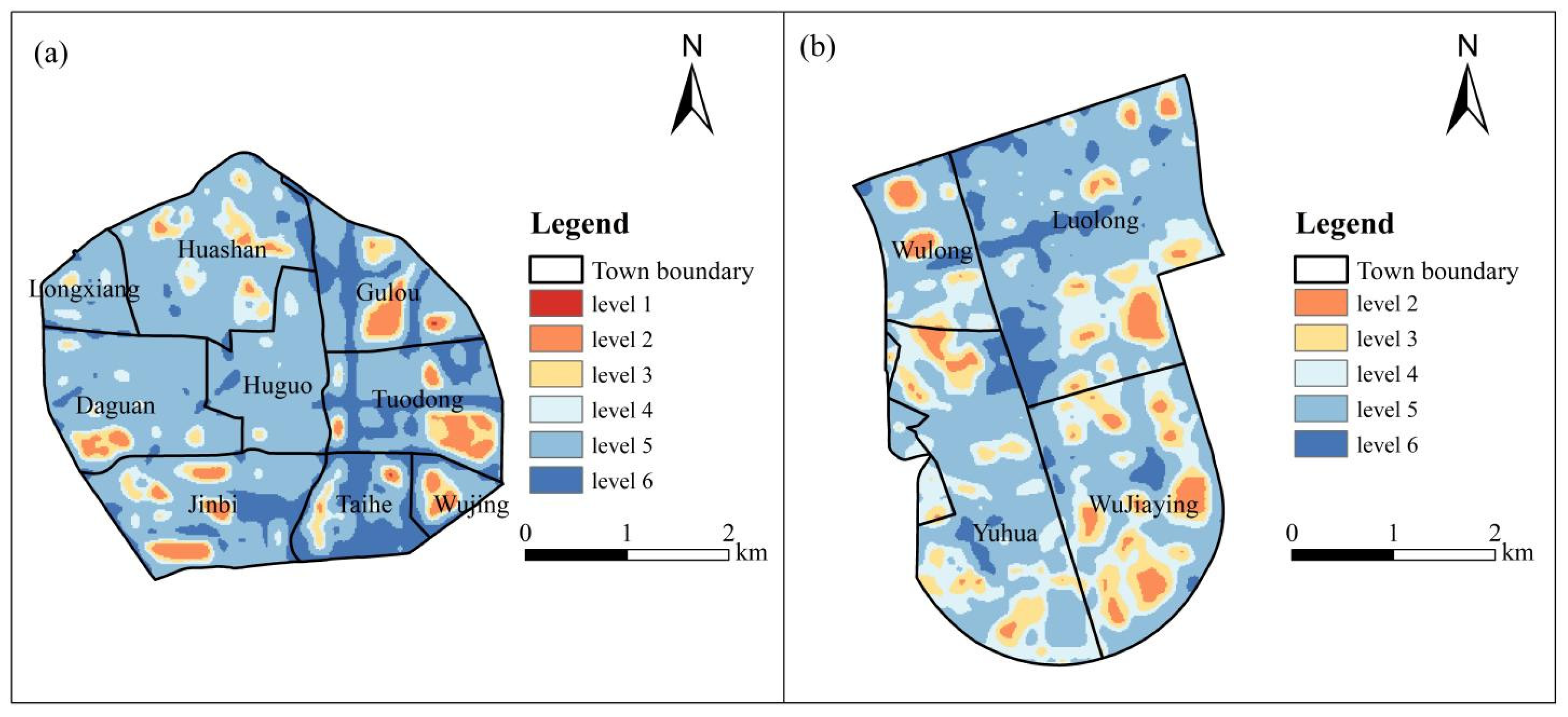

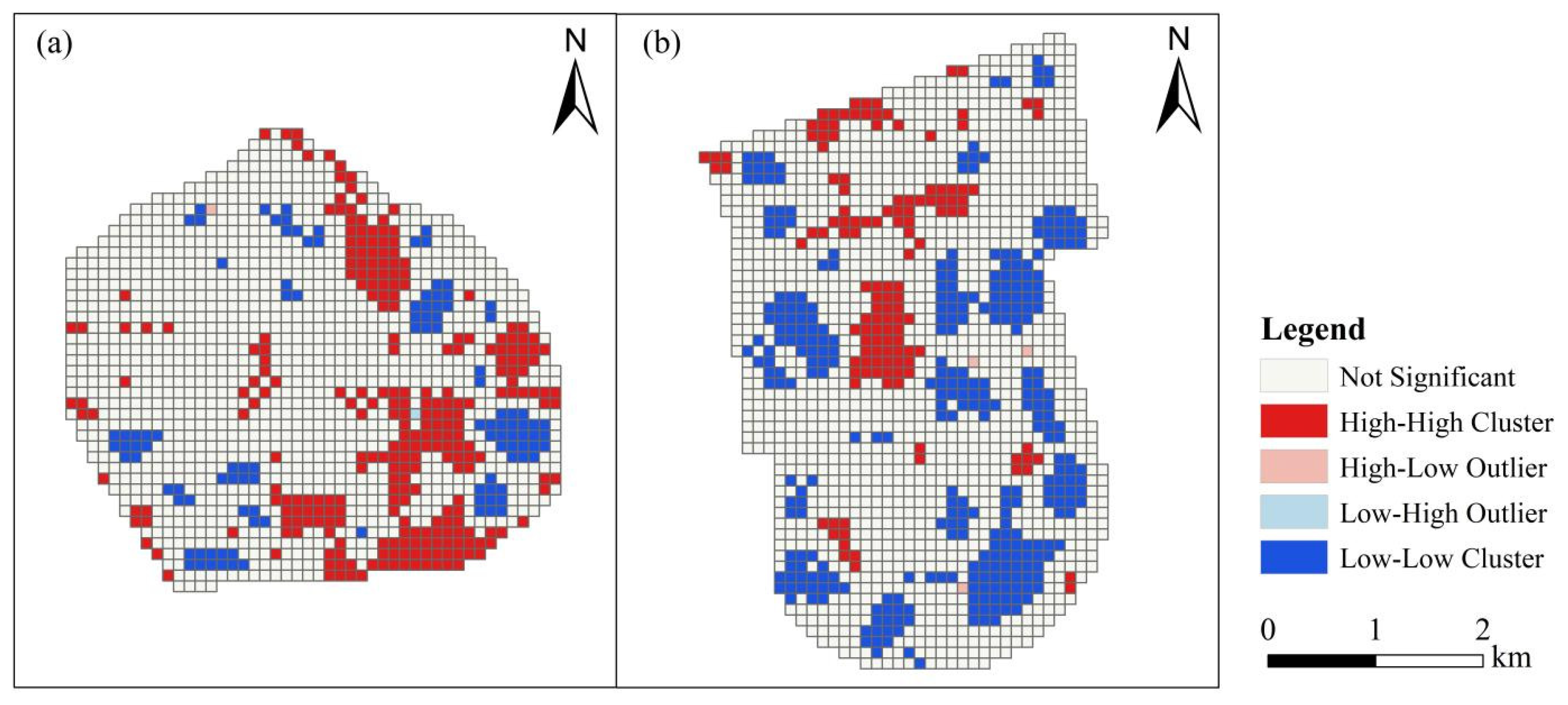
| Data | Spatial Resolution | Year | Scope or Quantity | Sources | |
|---|---|---|---|---|---|
| Administrative division | - | 2022 | Kunming City | Resource and Environment Science and Data Center | |
| GDP | 1 km | 2020 | Yunnan Province | ||
| Population density | 100 m | 2020 | Yunnan Province | World population | |
| DEM | 30 m | 2009 | Kunming City | ASTER GDEM 30M | |
| Land use type | - | 2022 | Kunming City | The Third National Land Survey | |
| POI data | Charging pile | - | 2023 | 54 | Amap Data collection technology |
| Bus stop | - | 2023 | 258 | ||
| Hospital | - | 2023 | 25 | ||
| Financial services | - | 2023 | 225 | ||
| Cultural and sports venues | - | 2023 | 85 | ||
| Emergency shelter | - | 2023 | 30 | ||
| Carbon emission | - | 2021 | Kunming City | Carbon emission data of each prefecture-level city in China | |
| Road network | - | 2021 | Kunming City | Kunming Institute of Surveying and Mapping | |
| Drainage pipeline | - | 2021 | Kunming City | ||
| Architectural outline | - | 2021 | Kunming City | ||
| Regulating reservoir | - | 2021 | Kunming City | ||
| Rail transit lines | - | 2023 | Kunming City | Open-source maps | |
| Dimension | Indicator Layer | Description | Attribute | Source |
|---|---|---|---|---|
| Natural environment B1 | Green coverage rate C1 | Vegetation can trap rainwater, promote infiltration, reduce surface runoff, and lower the risk of urban flooding. | Positive | [47] |
| Slope C2 | Steep slopes accelerate the accumulation of rainwater in low-lying areas, which can easily lead to overloading of the downstream drainage system. | Negative | [49] | |
| Water area C3 | Lakes and rivers can store floodwater and alleviate the impact of heavy rain. | Positive | [23] | |
| Impervious ground area ratio C4 | Hardening the ground hinders rainwater infiltration and increases surface runoff. | Negative | [50] | |
| Community vulnerability and services B2 | GDP per capita C5 | Cities with a high economic level are more capable of investing in flood control facilities. | Positive | [50,51] |
| Population density C6 | High-density areas are prone to waterlogging due to overloading of the drainage system, and post-disaster evacuation is difficult. | Negative | [49] | |
| Medical service capability C7 | The higher the coverage rate of hospitals and clinics is, the stronger the post-disaster medical rescue capacity will be. | Positive | [52] | |
| Financial services capability C8 | Banks and insurance institutions can provide post-disaster financial support to accelerate recovery. | Positive | [45,53] | |
| Service ability of large sports venues C9 | Stadiums and the like can be used as temporary shelters to enhance emergency response capabilities. | Positive | [45] | |
| Infrastructure B3 | Per capita road area C10 | The road network affects the drainage efficiency and rescue passage capacity. | Positive | [51,52] |
| Rainwater pipe density C11 | The denser the pipe network is, the stronger the drainage capacity will be. | Positive | [47] | |
| Rain and sewage diversion ratio C12 | The diversion system can prevent overflow pollution and drainage blockage in the combined sewer system. | Positive | New indicator | |
| Regulating reservoir service capacity C13 | The reservoir can temporarily store rainwater and reduce the peak flood flow. | Positive | [23,53] | |
| Emergency shelter service capacity C14 | Shelters can reduce casualties during disasters. | Positive | [45] |
| Dimension | Indicator Layer | Description | Attribute | Source |
|---|---|---|---|---|
| Carbon emissions and absorption B4 | Land attribute carbon emission C15 | The carbon emission intensities of different land-use types vary significantly. | Negative | [54] |
| Carbon emissions per capita C16 | It directly reflects the carbon footprint of residents’ lives and economic activities. | Negative | [46,55] | |
| Green coverage C17 | Vegetation sequesters carbon through photosynthesis and is an important natural carbon sink. | Positive | [56,57] | |
| Sustainable transportation B5 | Road network density C18 | It affects traffic efficiency and the choice of travel methods. | Positive | [55] |
| Rail transit density C19 | High-capacity public transportation can significantly reduce per capita transportation carbon emissions. | Positive | [56] | |
| Charging station service capability C20 | Support the popularization of new energy vehicles and replace fuel vehicles. | Positive | [46,55] | |
| Non-motorized lane network density C21 | Promote zero-carbon travel, such as walking and cycling. | Positive | [55] | |
| Public transport station service capacity C22 | Improve public transportation accessibility and reduce reliance on private cars. | Positive | [46] | |
| Socio-economic conditions B6 | GDP per capita C23 | The economic level affects the ability to apply low-carbon technologies. | Positive | [48] |
| Building density C24 | It affects energy utilization efficiency and the heat island effect. | Negative | [57] |
| Coupling Coordination Degree D | Coordination Level | Type of Coupling Coordination |
|---|---|---|
| 0–0.2 | level 1 | Extreme dysregulation |
| 0.2–0.4 | level 2 | Moderate dysregulation |
| 0.4–0.5 | level 3 | Mild dysregulation |
| 0.5–0.6 | level 4 | Elementary Coordination |
| 0.6–0.8 | level 5 | Intermediate Coordination |
| 0.8–1.0 | level 6 | High Coordination |
| Coupling Degree C | Coupling Grade | Type of Coupling |
|---|---|---|
| 0 | level 1 | No coupling |
| 0–0.3 | level 2 | Low-level coupling |
| 0.3–0.5 | level 3 | Antagonistic stage |
| 0.5–0.8 | level 4 | Run-in stage |
| 0.8–1.0 | level 5 | High-level coupling |
| 1 | level 6 | Benign resonant coupling |
| Number | Type | Factor | q Statistic | p Value |
|---|---|---|---|---|
| C1 | Natural environment | Green coverage rate | 0.026 | 0.000 |
| C2 | Slope | 0.027 | 0.000 | |
| C3 | Water area | 0.027 | 0.120 | |
| C4 | Impervious ground area ratio | 0.024 | 0.000 | |
| C5 | Socio-economic conditions | GDP per capita | 0.050 | 0.000 |
| C6 | Population density | 0.130 | 0.000 | |
| C7 | Medical service capability | 0.360 | 0.000 | |
| C8 | Financial services capability | 0.253 | 0.000 | |
| C9 | Service ability of large sports venues | 0.120 | 0.000 | |
| C10 | Infrastructure | Per capita road area | 0.213 | 0.000 |
| C11 | Rainwater pipe density | 0.358 | 0.000 | |
| C12 | Rain and sewage diversion ratio | 0.415 | 0.000 | |
| C13 | Regulating reservoir service capacity | 0.099 | 0.000 | |
| C14 | Emergency shelter service capacity | 0.171 | 0.000 |
| Number | Type | Factor | q Statistic | p Value |
|---|---|---|---|---|
| C15 | Carbon emissions and absorption | Land attribute carbon emission | 0.034 | 0.000 |
| C16 | Carbon emissions per capita | 0.032 | 0.000 | |
| C17 | Green coverage | 0.041 | 0.000 | |
| C18 | Sustainable transportation | Road network density | 0.292 | 0.000 |
| C19 | Rail transit density | 0.111 | 0.000 | |
| C20 | Charging pile service capability | 0.444 | 0.000 | |
| C21 | Non-motorized lane network density | 0.233 | 0.000 | |
| C22 | Public transport station service capacity | 0.433 | 0.000 | |
| C23 | Socio-economic conditions | GDP per capita | 0.031 | 0.000 |
| C24 | Building density | 0.010 | 0.025 |
| Coupling Level | Level 1 | Level 2 | Level 3 | Level 4 | Level 5 | Level 6 |
|---|---|---|---|---|---|---|
| TC | 0 | 0 | 3 | 26 | 1243 | 210 |
| LC | 0 | 0 | 0 | 19 | 1438 | 189 |
| proportion | 0.00% | 0.00% | 0.10% | 1.44% | 85.71% | 12.76% |
Disclaimer/Publisher’s Note: The statements, opinions and data contained in all publications are solely those of the individual author(s) and contributor(s) and not of MDPI and/or the editor(s). MDPI and/or the editor(s) disclaim responsibility for any injury to people or property resulting from any ideas, methods, instructions or products referred to in the content. |
© 2025 by the authors. Licensee MDPI, Basel, Switzerland. This article is an open access article distributed under the terms and conditions of the Creative Commons Attribution (CC BY) license (https://creativecommons.org/licenses/by/4.0/).
Share and Cite
Zhang, Z.; Zhou, D.; Zhu, L.; Xie, Z.; Cheng, W.; Yang, Q.; Wang, J.; Yuan, Z.; Liu, Y.; Li, Y.; et al. Comparison of Flood Resilience Between Low-Carbon and Traditional Communities: A Case Study of Kunming, China. Land 2025, 14, 1368. https://doi.org/10.3390/land14071368
Zhang Z, Zhou D, Zhu L, Xie Z, Cheng W, Yang Q, Wang J, Yuan Z, Liu Y, Li Y, et al. Comparison of Flood Resilience Between Low-Carbon and Traditional Communities: A Case Study of Kunming, China. Land. 2025; 14(7):1368. https://doi.org/10.3390/land14071368
Chicago/Turabian StyleZhang, Zheng, Dingjie Zhou, Ling Zhu, Zhiqiang Xie, Wei Cheng, Qijia Yang, Junxiao Wang, Zhiyong Yuan, Yifei Liu, Yufei Li, and et al. 2025. "Comparison of Flood Resilience Between Low-Carbon and Traditional Communities: A Case Study of Kunming, China" Land 14, no. 7: 1368. https://doi.org/10.3390/land14071368
APA StyleZhang, Z., Zhou, D., Zhu, L., Xie, Z., Cheng, W., Yang, Q., Wang, J., Yuan, Z., Liu, Y., Li, Y., Wen, P., Bai, S., & Zhao, S. (2025). Comparison of Flood Resilience Between Low-Carbon and Traditional Communities: A Case Study of Kunming, China. Land, 14(7), 1368. https://doi.org/10.3390/land14071368





